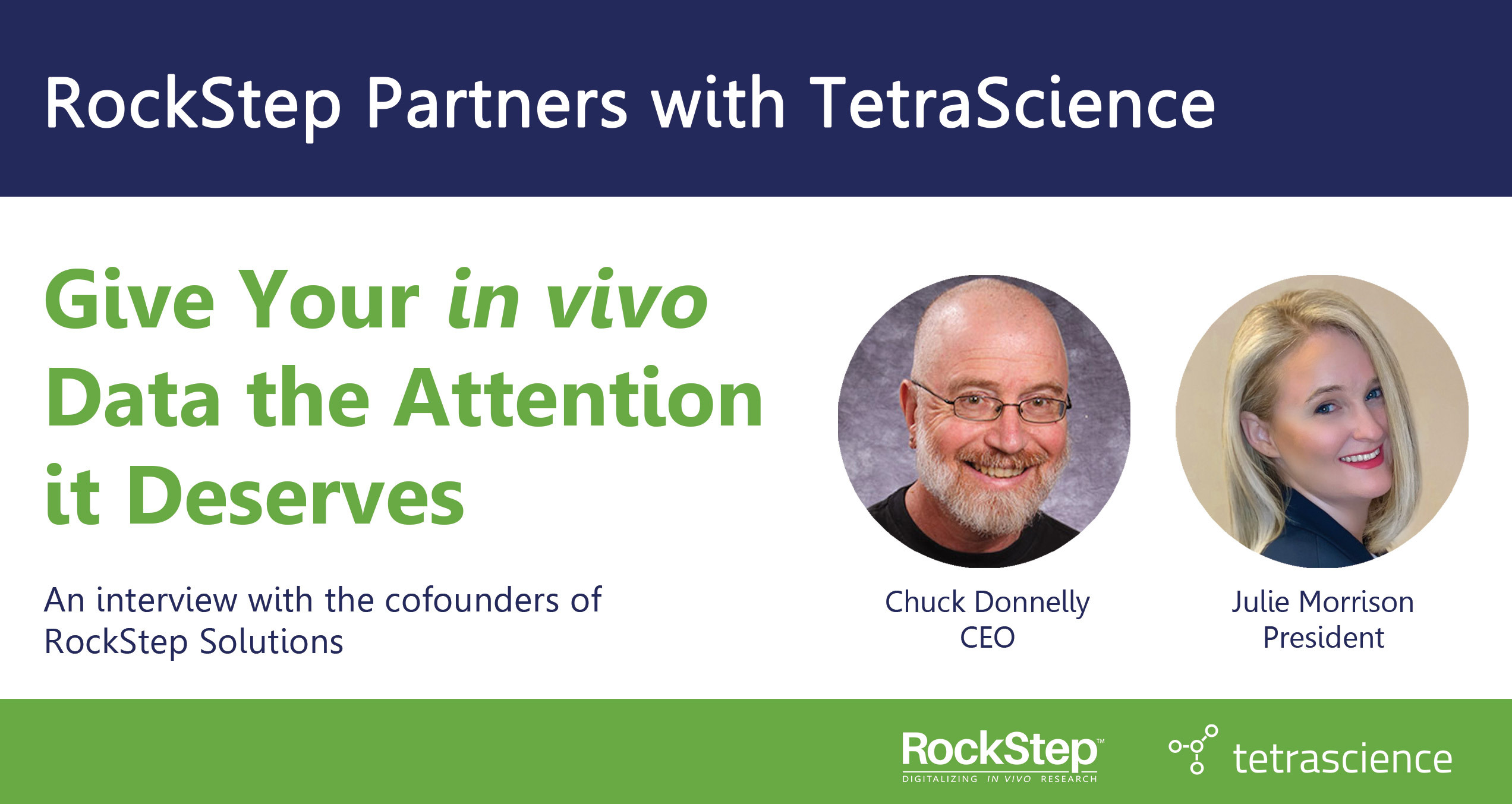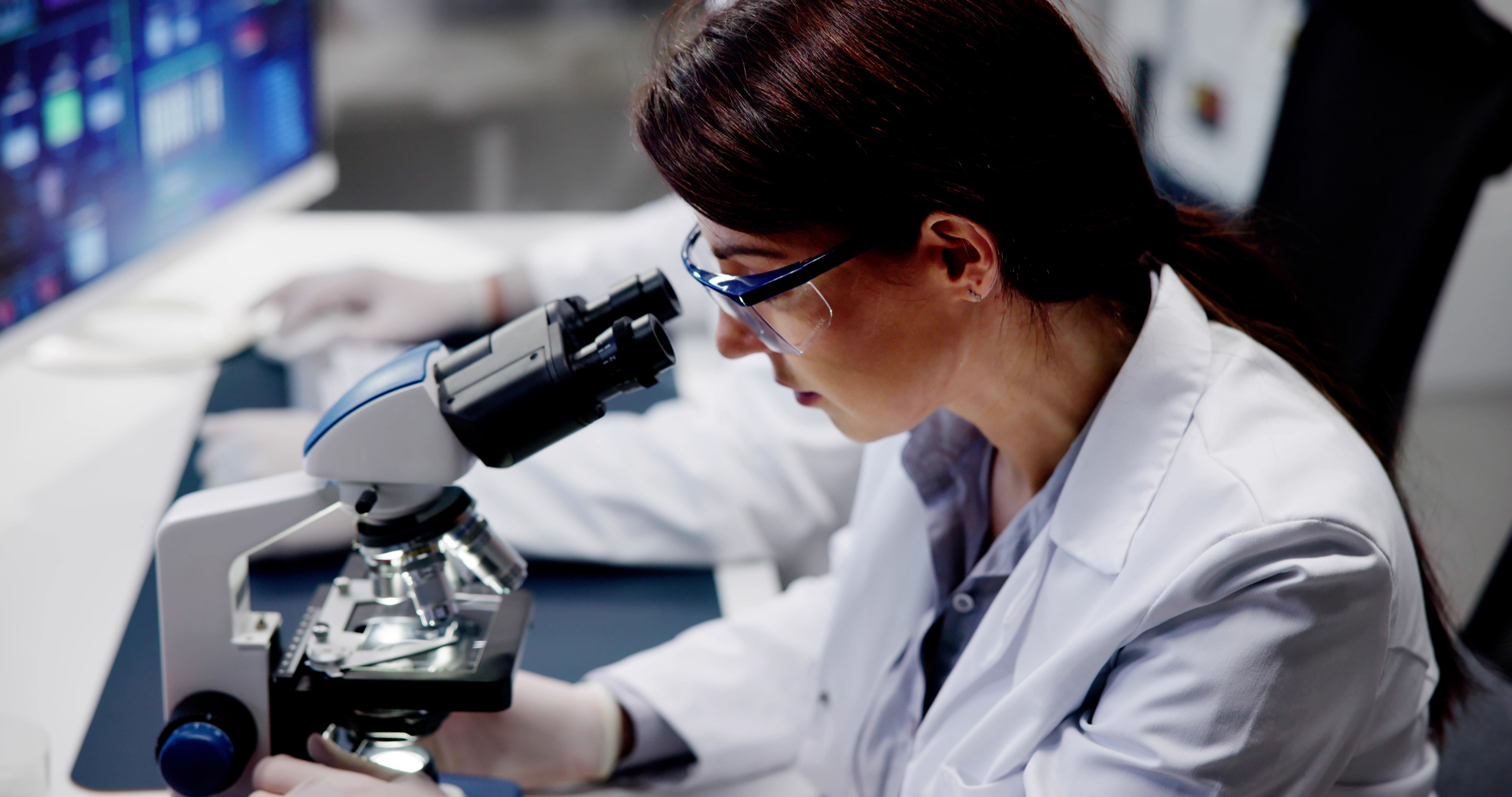
We recently partnered with TetraScience to continue addressing the data challenges of in vivo research. Below is an interview our CEO Chuck Donnelly and President Julie Morrison gave to TetraScience shortly after our partnership was finalized.
An interview with RockStep Solutions Co-Founders: Julie Morrison, President, and Chuck Donnelly, CEO.
Please tell us about your background(s).
Chuck: I’m the CEO of RockStep Solutions. Prior to starting RockStep, I was Director of Computational Sciences at the Jackson Laboratory (JAX), where I was funded by the NIH to develop informatics solutions for in vivo research and lead teams that worked on intractable computational problems for numerous disease areas, including cancer and diabetes. Before JAX, I was in the Space Astrophysics Group at UC Berkeley where I directed development of software systems for NASA orbiting platforms and led development of algorithms for signal processing and signal identification, in the search for extraterrestrial life.
Julie: I’m the President of RockStep Solutions: I have a degree in Microbiology and before joining RockStep I was at IDEXX labs developing assays for detecting contamination in public water supplies and at the Jet Propulsion Laboratory developing assays for detecting biological surface contamination for deep space missions. Over the past six years, I’ve spent a great deal of my time working with researchers in designing, developing, and testing the Climb solution. I’m also a passionate proponent of UX design for life sciences applications; toward that end, I’m a Project Champion for the UXLS team with the Pistoia Alliance.
Why did you create RockStep and how did you choose the company name?
Chuck: During my time at JAX I was funded by the NIH to develop a database LIMS called JCMS. JCMS was designed and built to manage animal breeding and in vivo studies. With a lot of hard work and support from JAX and NIH, our team of experts brought JCMS to the research community where it became an industry standard solution used globally by leading industry and academic research organizations. As modern cloud and mobile technologies matured, we recognized that these emergent technologies could transform how research workflows were conducted.
At the time, the NIH was investing about 12 billion annually into animal model research. They also recognized the need to modernize the available tools for in vivo researchers to improve efficiencies, reduce animal burden, and increase experimental reproducibility.
“I approached the NIH with my vision of developing an in vivo research management platform utilizing emergent cloud and mobile technologies and I was ultimately awarded three Small Business Innovative Research awards totaling $1.85M of seed funding.”
With NIH support in hand, I approached the Maine Technology Institute (MTI) and secured some additional early financing in the form of a Development Loan. At this point, I had enough funds to pay a small team and rent some office space and start to develop a prototype solution. Shortly after getting started, I connected with Dr. Stanley Prusiner’s Institute of Neurodegenerative Diseases (IND) at UCSF and the efforts ramped up quickly. While I had early financing, I still needed more expertise in the area of lab research to help develop the product vision. In 2016, Julie Morrison joined the team as a co-founder. Julie quickly took over the product and operations which allowed me to focus on the business and financing. Having the right business partner and enough financing to get started, RockStep Solutions and Climb™ were born! I also want to give credit to many investors who believed in us and helped us along the way so we could continue to make payroll and grow.
“The name RockStep represents quality and stability as well as growth and movement. A strong company is developed by a strong team of value-driven, aligned, and committed people along with a lot of good decisions and continuous learning.”
The name RockStep represents quality and stability as well as growth and movement. A strong company is developed by a strong team of value-driven, aligned, and committed people along with a lot of good decisions and continuous learning.
As drug discovery and development addresses more chronic and intractable diseases, the research gets more complex and expensive. RockStep’s Climb software helps labs “climb out of data chaos,” and ultimately helps get cures to market faster.
What are the current challenges involved in conducting in vivo studies?
“The most pressing challenges facing in vivo research today are related to data management and operational efficiencies.”
In vivo research studies are becoming increasingly complex as pharmaceutical companies and biotechs focus on the more challenging diseases of cancers, diabetes, and other chronic disorders. Data scientists spend far too much of their time wrangling data rather than doing the analysis that brings value to this research. Additionally, operational complexities make it difficult to schedule resources, track time-critical tasks, and manage chain of custody. Making matters worse, data often end up in data silos where they are stored after being used only once and are never used again.
It is not unusual to find a single share folder with thousands of spreadsheets of study data. These data stores require highly skilled data wranglers to locate, QC, merge, aggregate, and harmonize for analysis. These manual processes are costly, error-prone, and can lead to missed discovery opportunities or false starts at a time when efficiency and quality are required to be competitive. As the complexity of studies and the data they generate increases, so does the need for a comprehensive way to manage, aggregate, and deliver the data to the scientist or the FDA for analysis.
Who are your customers and how do you help them?
“RockStep developed Climb 2.0 under Julie Morrison’s leadership, in partnership with Novartis, UCSF, and a large public Biotech.”
With Climb, we are providing a scalable, complete solution that addresses the entire spectrum of challenges in one integrated package. We help our customers take control of their research and data to make it work for them, getting more science done and the right drugs to market faster.
How easy is it to adopt your solutions?
Julie: As a native-cloud platform, Climb is browser-based and requires no installation or on-site hosting. Our customer support team provides comprehensive training, live support, and assistance with migrating data from legacy systems when needed. Climb also features a modern RESTful API for easy integration with lab equipment or other platforms. Excellence in customer experience is one of our company’s guiding principles, and our team will be there to support our customers during every step of the onboarding process.
How does your product, Climb, contribute to better animal welfare?
How does your product, Climb, contribute to data integrity?
What trends are you seeing within the pharmaceutical value chain?
In order to increase efficiencies, data and operations must be harmonized so that experimental results meet standards of quality and studies are reproducible. Data needs to be treated as a first-class asset and made findable, accessible, secure, and reusable, while scientists must have access to these high-quality data across the organization. Data volumes have grown so significantly in the past decade that AI algorithms are now required to sift through data to find patterns that can open paths for new discoveries.
The cost of drug development has peaked at about $2B and it takes a decade to get a single drug from concept to FDA approval. Each day a drug takes in discovery and development runs at a cost of nearly $500,000, while each day a drug is in the market can drive $1M or more of revenue for the drug company.
Considering the enormous numbers of studies and volumes of data required to get a drug to market, companies are digitalizing with cloud-based research management tools like Climb. Modern solutions like Climb can integrate with ELNs and LIMS, which are also necessary to keep up with the fast pace and high throughput requirements of the biopharma industry. Digitalizing the research lab also ensures that organizations are as prepared as possible for AI and future technology advancements. Automation and smart labs are the future and the digitalized laboratory provides the foundation for adopting these next generation technologies.
What are the benefits of being part of the Tetra Partner Network?
“We are excited to be part of the Tetra Partner Network, because it helps put our customers back in control of their data at a much larger scale than RockStep can as a single company.”
Is there anything else you’d like to share with us?
RockStep’s in vivo management solution Climb helps labs get more cures to market faster. Take the video tour or request a demo!




